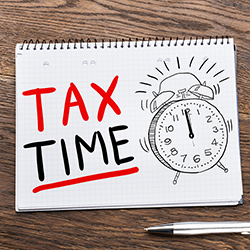
March 2020
For many, filling out an income tax form can be a headache. When you’re doing so close to the deadline, that headache can turn into a stress-induced migraine. Here are seven strategies to ace your taxes when you’re running short on time.
Give yourself a deadline
For 2020, the IRS has set April 15 as the final deadline for submitting tax forms. However, it’s wise to set an earlier deadline for yourself. Aim to finish and file your tax return at least one to two days before the actual deadline, per CNBC contributor Jessica Dickler. This will help ensure that you have sufficient time for accurately completing the form a bit before the IRS deadline.
Gather the right forms
Filing taxes is a bit like cooking a recipe. You’ll want to gather the ingredients you’ll need beforehand, so the actual cooking process goes smoothly. Before starting to fill out the tax form, CNBC advises that you gather the following documents: W-2s, 1099-Rs, your social security number, bank routing information, any receipts that you might need, and student loan interest.
Familiarize yourself with tax credits
Help maximize your tax return by adequately researching available tax credits, per The Motley Fool contributor Maurie Backman. There are a variety of credits you might qualify for, based on individual circumstances. For instance, if you fall into the low to moderate income level bracket, you can earn up to $2K back, if you make regular contributions to a 401(k) or eligible retirement plan.
Consider e-filing
Help save the trees while saving yourself time and stress by filing your taxes electronically. To this end, the IRS offers an e-file option. An added bonus of filing electronically is that your tax return will be more accurate. The IRS claims that an individual is 20 times less likely to make a mistake on an electronic tax form than a paper one. The e-filing program’s software will notify you of any credits and deductions you might have overlooked. It will also catch errors so you can correct them before submission.
Use last year’s application as a reference
Save even more time on this year’s return by using last year’s form as a model, as Dickler recommends. Unless you’re a professional tax-return preparer, it’s easy to forget what deductions you claimed in the past year. As long as your financial and personal circumstances haven’t undergone any major changes, it’s likely that this year’s application will look a lot like last year’s.
Review the application thoroughly before submitting
When you’re short on time, you might be tempted to submit your tax form before double- and triple-checking it. Any errors on the form however can result in a rejected return or an audit. Avoid these two scenarios by thoroughly reviewing the form before turning it in. Some of the most common errors are simple ones, such as misspelled words, incorrect social security numbers and math errors, as Backman articulates.
Ask for a deadline extension
If you still need a bit more time to complete your tax form, you can request a six-month extension. Per the IRS, you can do this electronically through tax software by using Form 4868. Please note that although the extension does provide a bit more time to file your taxes, the actual tax payments are still due by the IRS’s tax form deadline (which is April 15, for 2020).
By implementing these practical tips, you’re well on your way to beating the clock and filing an accurate tax return by the IRS’s deadline.
